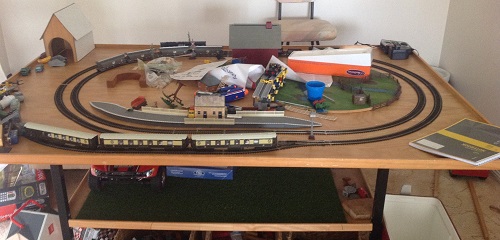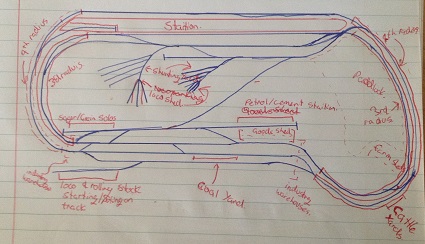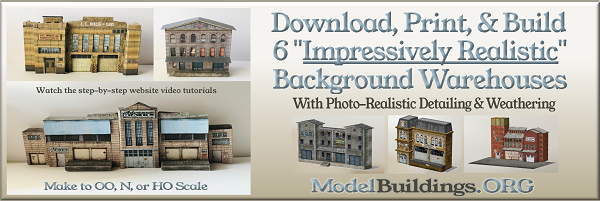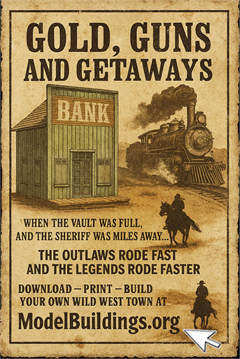Everything on model trains, model railroads, model railways, locomotives, model train layouts, scenery, wiring, DCC and more. Enjoy the world's best hobby... model railroading!
Beginner Asks For Your Help
 Matthew is new to the hobby and would like some advice from experienced model railroaders. This photos shows the beginnings of his layout which he hopes to expand (see photo of plan). He is however having a few problems, so use the comments link to add any suggestions you have to help him get started.
Matthew is new to the hobby and would like some advice from experienced model railroaders. This photos shows the beginnings of his layout which he hopes to expand (see photo of plan). He is however having a few problems, so use the comments link to add any suggestions you have to help him get started.
 In Matthew’s own words: “My trains keep stopping at certain parts of curves and on switches. I have the Hornby controller. Can someone please give me some advice?
In Matthew’s own words: “My trains keep stopping at certain parts of curves and on switches. I have the Hornby controller. Can someone please give me some advice?
8 Responses to Beginner Asks For Your Help
Leave a Reply















I had the same problem with my new hornby, (Looks like we have the same kit). Make sure of a few things.
1 – tracks are absolutely clean.
2. All connections are correctly inserted between rail sections.
3. Loco wheels are also clean
At one stage my loco disn’t want to go at all. I did a factory reset on the SELECT and changed the loco adress. And wolla.. all was good again.
Cheers
Have a good one.
All of the above but make sure that the fish plates that joint the rails together are making a good contact. I usually solder mine but keep the solder small and to out side of the rails as any solder on the inside of the rails can lead to derail problems if you get solder on the top of the rails file the top of the rails with a very fine file making sure that the top of the rail is smooth so that rolling stock does not jump.
To the person whose trains keep stopping. Your track plan ha 2 different reverse lopse which need to be wired correctly to prevent the trains from stopping whenever they leave the reverse loop otherwise the short circuit will stop the trains. good luck.
Matt-How many feeders do have and are they no more than 3 ft apart? I thought I had enough on my layout but I had the same problem you’re having. Added more as recommended, and walla-problem solved. Switches are another problem. I hope someone with more knowledge will help you out.
first of all the previous comment had no validity at all to your question you are running DC not DCC first I would make sure that all my frogs in switches are not insulated but are metal and can be connected to the power source..making sure all connections between tracks are good and you are not using a ballast that is magnetic..for this will interfere with the conductivity and attenuation that occurs with electricity and electromagnetic fields..and its crazy what a little residue will do on the wheels of your loco keep them clean:)
We all feel your frustration Matthew, getting equipment to run reliably is one of the biggest challenges of our hobby. The likely source for your problems are in the track and it’s connections. Track should be securely fastened to the table with glue and/or pins to keep the track from moving. Experienced modelers solder every joint in the track to keep the electrical connection strong. Additionally, a system of wires running from the controller to the track is needed, with many feeder wires running from the main (buss wires) to the track. Ideally, each track piece, including turnouts, have their own feeder wires.
The second important step is to keep the track clean and the wheels of your locomotives clean. Commercial products are available which do an excellent job of cleaning track and trains. Be sure to do cleanings on a schedule if possible, or every time you plan to run trains. You may want to think about purchasing a track cleaning car which will clean the track as you run trains. This works well for people who have a lot of track to clean.
The third and final thing that is recommended is to replace all the plastic wheels with metal wheels. This adds weight to the cars, lowering the center of gravity, and will aid in keeping track clean since plastic wheels give off a residue that prevents adequate electrical contact.
Have fun, and I hope you get to play trains more than clean track!
–James
You do not give enough information about your problem, but it sounds as if some sections of track may not be getting a reliable electrical feed. Most people do not rely on rail connectors to carry current. The recommended procedure is to run a bus under the layout and run feeders to the tracks above. Some recommend connections at least every meter (3 feet). I followed this rule on a small layout and have had no problems. If you are dubious about so much soldering (it can be a little tricky to avoid melting the plastic ties), I believe Atlas makes rail connectors with wires already soldered on. If I used those, I would use them at every connection just to be sure. Good luck.
Hi Matthew. Wow, quite a lot of advise there! I’ll try and break it all down for you in lay-mans/beginners terms…
– Buy a track rubber and clean the track. (Literally a rubber square that you rub the track with!)
– Make sure your track is joined closely together, with no gaps between the rails.
– Check you haven’t bent the tracks (you can ‘gauge’ the track with a carriage or truck by hand and eye or buy a gauge at your hobby store to check this).
– Check to loco and make sure no fluff, dirt or debris is in there, especially the wheels.
– You have two loops there. Are you using separate controllers for each loop? You should really.
– Are you using DC? (ie turning a dial and the train goes!) or are you using DCC? (programming a handset controller)
– If you are using DC then the above should work on the layout you have in the photo.
– If you are using DCC then i would also suggest more wiring connections are needed. Especially if using more than one loco/engine. DCC loves power connectors!
– If DCC, have you programmed your loco/controller properly? Reset the system and try again to be sure.
– If none of this works, take your locos to your local hobby store to check it.
ALSO:
– Richard Price is correct regarding your track plan. The track running through the middle of your layout, from lower left to upper right, in your track plan is called a “reverse loop” and will cause a short circuit – take it out of your plan for now until more experienced. (If you follow the positive feed you’ll see it hits the negative feed because of this reverse loop and causes a short curcuit!)
– Buy a “track plans” book or leaflet for ideas, plans and inspiration!
Hope this helps.